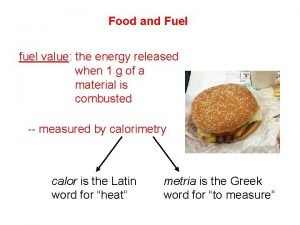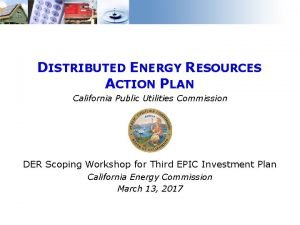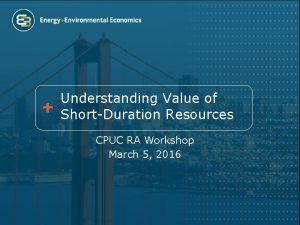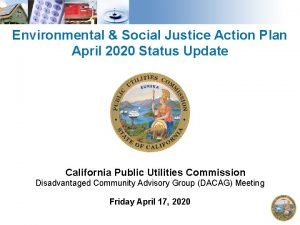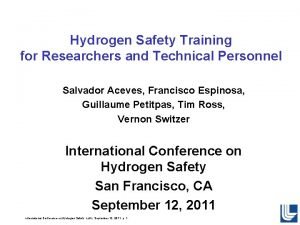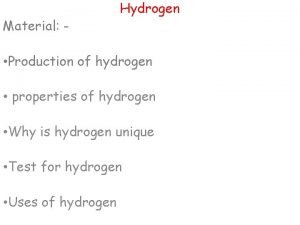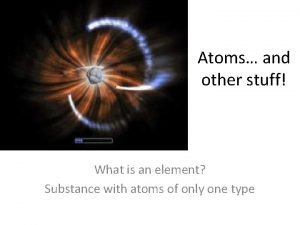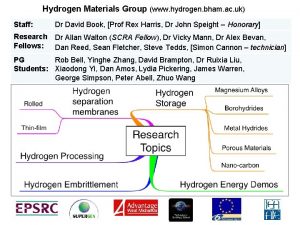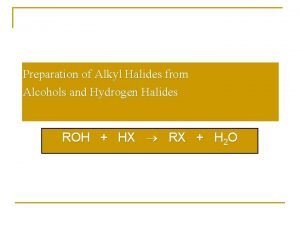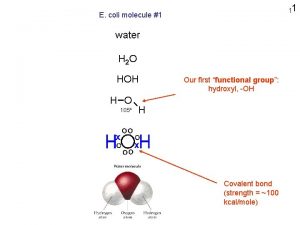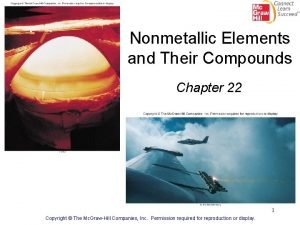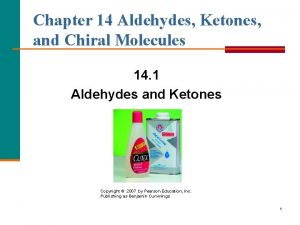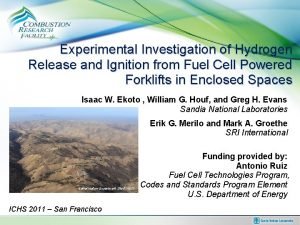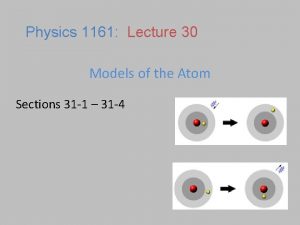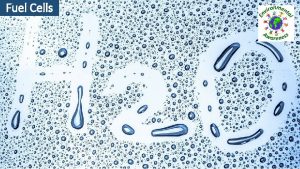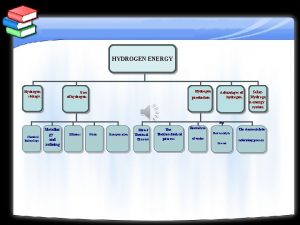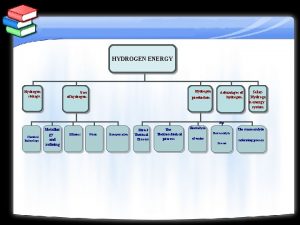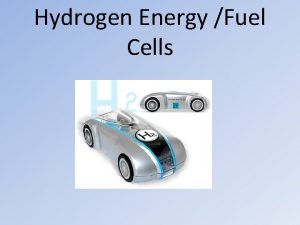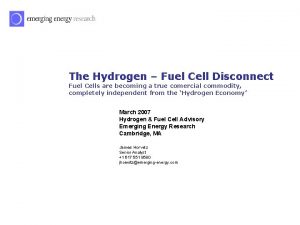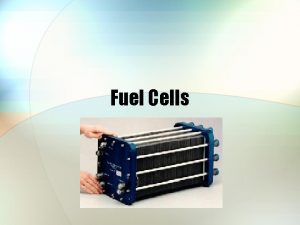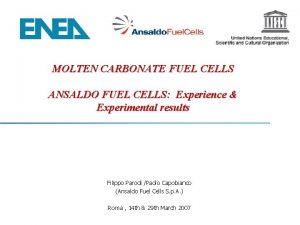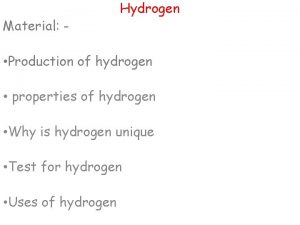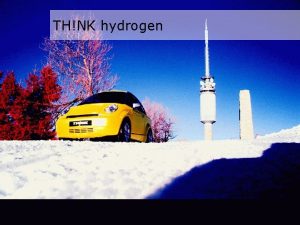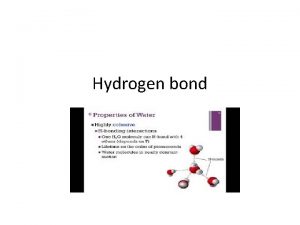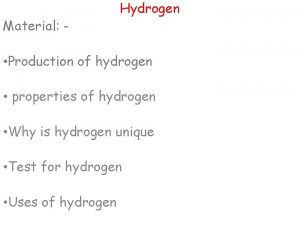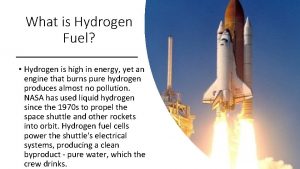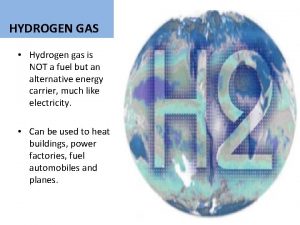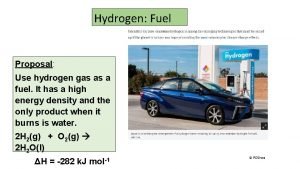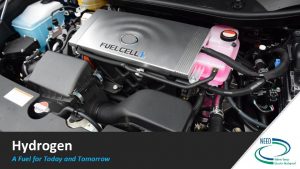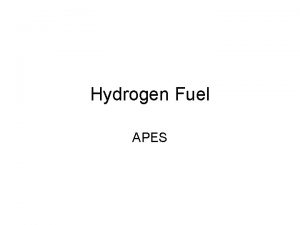Society Needs Hydrogen Fuel Cells CPUC Workshop 24









































- Slides: 41

Society Needs Hydrogen & Fuel Cells CPUC Workshop 24 May 2019 Jeff Reed, Ph. D. Jack Brouwer, Ph. D.

Outline • Context – why hydrogen (and fuel cells) matter • Hydrogen production technology and cost • Hydrogen, fuel cells and the grids • Key questions © National Fuel Cell Research Center, 2019 2/40

UC Irvine Advanced Power and Energy Program Hydrogen Research Partial list of relevant research activities • Microgrid Power-to-Gas (electrolyzer => gas turbine combined cycle) including hydrogen leak testing and embrittlement modeling (So. Cal. Gas) • Renewable Hydrogen Production Roadmap – current and future technoeconomics (CEC Clean Transportation Program (AFVRTP)) • Hydrogen blend testing in appliances (SCAQMD) • Wind energy storage using Texas salt cavern • Simulation of electrolyzers as a grid resource (various) • Extensive body of research and development on fuel cell and electrolyzer technology through the UCI-hosted National Fuel Cell Research Center © National Fuel Cell Research Center, 2019 3/40

What is Hydrogen Properties • The lightest element • Commonly present on earth bound to oxygen (water) or carbon (hydrocarbons) • When isolated (as a gas) H 2 molecules • • • Boiling point -423°F Colorless Odorless Tasteless Non-toxic Energetic and clean burning – zero carbon © National Fuel Cell Research Center, 2019 Hydrogen – H 2 molecule picture From: princeton. edu 4/40

Getting to Zero Term Definition Biogas Mixture of methane (major constituent) and CO 2 (typically 20% to 40% CO 2 by volume) and minor constituents derived from bio sources – cannot be introduced onto the common carrier natural gas system without cleanup Biomethane Biogas that has been conditioned (cleaned and purified) to meet pipeline standards comprised primarily of methane with small remaining amounts of CO 2 Syngas Hydrogen rich gas (with high fraction of carbon monoxide, CO) produced through gasification of biomass, from which (near) pure hydrogen or methane (with additional CO 2) can be synthesized Renewable Methane formed by combining hydrogen (generally from electrolysis) with CO 2 – it is renewable if the feedstock for the hydrogen is renewable and if the CO 2 is biogenic or captured from the atmosphere or other source of CO 2 certified to be climate-neutral Renewable Natural Gas While generally used interchangeably with biomethane, includes as well renewable electrolytic methane Renewable or Green Hydrogen produced through electrolysis using renewable electricity or reformation of methane derived from renewable feedstocks such as organic material Renewable Gas All of the above Zero Carbon All of the above and any other hydrogen or methane produced through processes that emit no net carbon to the atmosphere including processes with no carbon emissions and those whose carbon emissions are captured (also called Carbon-Neutral or Zero. Net-Carbon) © National Fuel Cell Research Center, 2019 5/40

Why Hydrogen & Fuel Cells Part of the solution to Sustainability – the shift to use of primary energy at same rate it is naturally replenished on earth (solar, wind, hydro, waste, …) and use it benignly • Criteria Pollutant Emissions o o o Acid Rain Particulate Matter Volatile Organic Compounds Nitrogen and Sulfur Oxides Carbon Monoxide Serious Health and Air Quality Consequences Los Angeles • Greenhouse Gas Emissions – climate impacts o • • Carbon dioxide, methane, nitrous oxide, … Beijing Resource recovery damage (e. g. , mines) Water “use” (H 2 O returned to environment with fuel cell) Regional resource depletion – energy geopolitical dependencies Overall primary energy resource depletion – not sustainable © National Fuel Cell Research Center, 2019 6/40

Why Hydrogen & Fuel Cells • Hydrogen is foundational to the zero-carbon future Major hydrogen initiatives by: • European Union • Japan • Australia • Korea • China © National Fuel Cell Research Center, 2019 7/40

Why Hydrogen & Fuel Cells Ideal for heavy, and longerdistance applications Aircraft SUVs and Light Trucks Shipping Fuel Cell Trains & Locomotives Fuel Cell Buses © National Fuel Cell Research Center, 2019 Fuel Cell: Zero Emissions Big Rig 8/40

Why Hydrogen and Fuel Cells California heading for 1000 hydrogen stations and up to 1 million FCEVs by 2030 2025 © National Fuel Cell Research Center, 2019 2030 9/40

Why Hydrogen & Fuel Cells Clean fuel for a wide range of applications Preliminary

Outline • Context – why hydrogen (and fuel cells) matter • Hydrogen production technology and cost • Hydrogen, fuel cells and the grids • Key questions © National Fuel Cell Research Center, 2019 11/40

How to Produce Hydrogen Organics Conversion Natural Gas w/ CCUS Anaerobic Digestion CO 2 Power-to-Gas Thermo-chemical Renewable Natural Gas Artificial Photosynthesi Electrolysis Renewable Hydrogen Reformation Methanation © National Fuel Cell Research Center, 2019 12/40

How to Produce Hydrogen • Hydrocarbon – Steam Reforming © National Fuel Cell Research Center, 2019 13/40

How to Produce Hydrogen Electrolysis • 2 H 2 O + Electricity 2 H 2 + 1 O 2 • 1 liter water yields ~ 1 Nm 3 H 2 • Typical System Power Demand: o 4 – 7 k. Wh/Nm 3 or o 45 – 78 k. Wh/kg (depending upon type) From: U. S. DOE © National Fuel Cell Research Center, 2019 14/40

Cost of Producing Hydrogen Cost per kg-RH 2 Current Technology and Nameplate Capacity © Advanced Power and Energy Program 201 Cost per kg-RH 2 2030 New Build Technology and Nameplate Capacity 15/40

Cost of Producing Hydrogen Electrolytic Hydrogen Production Cost in 2030 Timeframe Illustrative c/kwh (power price) $/kg (levelized production cost) RH 2 Production Cost Capex $500/kw - $800/kw Electricity Price Grid $2. 65 - $3. 15/kg Self Gen Max Capacity Factor for 100% Renewable Cumulative Annual Operating Hours • © National Representative case of self-generated solar augmented with wind PPA or spot purchases Fuel Cell Research Center, 2019 16/40

Outline • Context – why hydrogen (and fuel cells) matter • Hydrogen production technology and cost • Hydrogen, fuel cells and the grids • Key questions © National Fuel Cell Research Center, 2019 17/40

Hydrogen, Fuel Cells and the Grids Hydrogen is a clean, storable energy carrier Fuel Cell Hydrogen Storage Renewable Electricity © National Fuel Cell Research Center, 2019 Water In 18/40 Water Out

Hydrogen, Fuel Cells and the Grids Cost/availability of Solar & Wind make 100% energy amount possible … But Production and Demand DYNAMICS are a Challenge • B 2030 50% Renewable © National Fuel Cell Research Center, 2019 19/40

Hydrogen, Fuel Cells and the Grids Recent 1 -Year Simulation of 100% Renewable Grid in CA Wind dominant case (37 GW solar capacity, 80 GW wind capacity) Deficit Surplus © National Fuel Cell Research Center, 2019 20/40

Hydrogen, Fuel Cells and the Grids Recent 1 -Year Simulation of 100% Renewable Grid in CA Wind dominant case (37 GW solar capacity, 80 GW wind capacity) Season a al ason l Pumped Hydro Se Gas System Storage Potential if 100% H 2 Deficit Surplus 21 million EVs © National Fuel Cell Research Center, 2019 21/40

Hydrogen, Fuel Cells and the Grids RESOLVE 80% Renewables – May Day RESOLVE 80% Renewables – July Day Long duration storage Hour © National Fuel Cell Research Center, 2019 Hour 22/40

Hydrogen, Fuel Cells and the Grids • Compressed Hydrogen Storage complements Wind & Power Demand Dynamics in Texas (Salt Cavern Storage) Oct. 2 • Oct. 3 Oct. 4 Oct. 5 Oct. 6 Oct. 7 Oct. 8 Load shifting from high wind days to low wind days Maton, J. P. , Zhao, L. , Brouwer, J. , Int’l Journal of Hydrogen Energy, Vol. 38, pp. 7867 -7880, 2013 © National Fuel Cell Research Center, 2019 23/40

Hydrogen, Fuel Cells and the Grids • Weekly storage and seasonal storage possible with hydrogen and electrolyzers/fuel cells – all zero emissions! Weekly Seasonal Maton, J. P. , Zhao, L. , Brouwer, J. , Int’l Journal of Hydrogen Energy, Vol. 38, pp. 7867 -7880, 2013 © National Fuel Cell Research Center, 2019 24/40

Hydrogen, Fuel Cells and the Grids Issue: Lithium-Ion batteries lose their charge over time derating performance for long-duration storage Average RTE ~60% From: 2017 SGIP Advanced Energy Storage Impacts, Itron, E 3 © National Fuel Cell Research Center, 2019 25/40

Hydrogen, Fuel Cells and the Grids Simulate meeting TOTAL world electricity demand w/ Solar & Wind • How much storage is needed? 19, 981 TWh [Nuria Tirado, M. S. Thesis, 2018] • Batteries needed, but, they cannot do it all! o o © National Li req’d = 3, 144 Mt Co req’d = 25, 815 Mt (Not enough in the world) Only 53 Mt Li & only 25 Mt Co reserves Massive cost (connected power & energy scaling) Self discharge (measured performance in utility applications) Fuel Cell Research Center, 2019 26/40

Hydrogen, Fuel Cells and the Grids Relative Installed Cost HES get cheaper as storage duration increases © National Electrolysis (Power-to-Gas) using Gas grid storage and existing GTCC Fuel Cell Research Center, 2019 27/40

Hydrogen, Fuel Cells and the Grids Ability to Leverage Existing Infrastructure © National Fuel Cell Research Center, 2019 28/40

Hydrogen, Fuel Cells and the Grids • First mix up to X% (20%? ) • Then piecewise conversion to pure hydrogen – over 1600 miles of H 2 pipe in the US today • Projects to convert complete districts to pure hydrogen ongoing in France and the UK Solar Here! Close valves Here! © National Fuel Cell Research Center, 2019 29/40

Hydrogen, Fuel Cells and the Grids • Optimized, time-phased build-out of dedicated hydrogen transport system in the UK Moreno-Benito, Agnoluccib and Papaggeorgioua 2017 © National Fuel Cell Research Center, 2019 30/40

Outline • Context – why hydrogen (and fuel cells) matter • Hydrogen production technology and cost • Hydrogen, fuel cells and the grids • Key questions © National Fuel Cell Research Center, 2019 31/40

Issues and Questions How can hydrogen storage be cost effective with such a low round-trip efficiency? c/kwh (power price) $/kg (levelized production cost) Illustrative RH 2 Production Cost • HES round trip efficiency is likely to exceed 50% by 2030 • Efficiency is only one parameter however • Long-duration storage may not be feasible at the scale needed using other approaches • $20/MMBtu hydrogen produced from solar energy and converted in an existing 60% efficient resource costs $0. 11/k. Wh • With “free” electricity, the cost would be less than $0. 06/k. Wh Capex $500/kw - $800/kw Electricity Price Grid $2. 65 - $3. 15/kg Self Gen Max Capacity Factor for 100% Renewable Cumulative Annual Operating Hours © National Fuel Cell Research Center, 2019 32/40

Are Electrolyzers Dynamic Enough? HOGEN-RE proton exchange membrane electrolyzer • Hydrogen production dynamics (with and without clouds) © National Fuel Cell Research Center, 2019 33/40

Won’t Hydrogen Leak Faster? H 2 injection into existing natural gas infrastructure (low pressure) • NG, H 2/NG mixtures, H 2 leak at same rate 50 NG 10% H 2 Pressure (in. H 2 O) 45 40 35 30 25 20 15 -1 © National Fuel Cell Research Center, 2019 1 3 Day of Test 5 7 34/40

Won’t Hydrogen Leak Faster? • Results from a previous study (1992) support our recent findings! Leakage Flow Regime Ratio of flow between H 2 and CH 4 Diffusion (diffusion constant) 3. 15 Laminar (viscosity) 1. 29 Turbulent (density) 2. 83 • First publication on this topic: Swain & Swain, Int’l J. Hydrogen Energy, Vol. 17, pp. 807 -815, 1992. H 2, CH 4, and C 3 H 8 can leak at SAME RATE © National Fuel Cell Research Center, 2019 35/40

Can Leaks be fixed? Pressure (in. H 2 O) H 2 injection into existing natural gas infrastructure (low pressure) • Copper epoxy applied (Ace Duraflow®) Day of Test © National Fuel Cell Research Center, 2019 36/40

Don’t Pipelines Weaken When Exposed to H 2? Simulation of H 2 embrittlement and fatigue crack growth with University of Illinois – result = small impact on crack growth • Fatigue crack growth in 6” nat gas pipeline 0. 188” wall thickness: Hydrogen gas © National Fuel Cell Research Center, 2019 Air 37/40

Will appliances still work with hydrogen blends? • Ongoing testing of hydrogen blends in a variety of burner types to fractions up to 100% • Results (e. g. cooktop) generally show minimal effect to 20% blends with no flashback and minimal impact on NOx • Burner design changes could accommodate higher hydrogen fractions © National Fuel Cell Research Center, 2019 38/40

UCI P 2 G Pilot Demonstration – U. S. First! Injection into campus natural gas system followed by combustion of H 2/NG mixture in NGCC (400 psi line) © National Fuel Cell Research Center, 2019 39/40

UCI P 2 G Pilot Demonstration – U. S. First! Injection and combustion of H 2/NG mixture in NGCC (400 psi line) • Up to 3. 8 volume % H 2 in natural gas with no adverse impact © National Fuel Cell Research Center, 2019 40/40

Society Needs Hydrogen & Fuel Cells CPUC Workshop 24 May 2019 Jeff Reed, Ph. D. Jack Brouwer, Ph. D.
 Valuetheenergy.com
Valuetheenergy.com Cpuc der action plan
Cpuc der action plan Cpuc elcc
Cpuc elcc Cpuc environmental and social justice action plan
Cpuc environmental and social justice action plan Simple claustral complex
Simple claustral complex Strategic gender needs and practical gender needs
Strategic gender needs and practical gender needs Primary needs and secondary needs
Primary needs and secondary needs What is a learning need
What is a learning need Satisfaction
Satisfaction Why dna is more stable than rna?
Why dna is more stable than rna? Why did robert hooke name cells “cells”?
Why did robert hooke name cells “cells”? Regulation of tubular reabsorption
Regulation of tubular reabsorption Are red blood cells prokaryotic or eukaryotic
Are red blood cells prokaryotic or eukaryotic Ghonarea
Ghonarea Chlorocruorin
Chlorocruorin Masses of cells form and steal nutrients from healthy cells
Masses of cells form and steal nutrients from healthy cells Parafollicular
Parafollicular Nondisjunction in meiosis
Nondisjunction in meiosis What is an organelle
What is an organelle Pseudostratified vs simple columnar
Pseudostratified vs simple columnar Somatic cells vs gametes
Somatic cells vs gametes Cells and life lesson 1 answer key
Cells and life lesson 1 answer key Prokaryotic cells
Prokaryotic cells Submentovertical projection
Submentovertical projection 4 types of eukaryotic cells
4 types of eukaryotic cells Gertler econ
Gertler econ Hydrogen safety training
Hydrogen safety training Properties of hydrogen
Properties of hydrogen Hydrogen isotope with 1 neutron
Hydrogen isotope with 1 neutron Hydrogen carbonate indicator
Hydrogen carbonate indicator Star
Star Atomic hydrogen welding
Atomic hydrogen welding Hydrogen storage
Hydrogen storage Preparation of alkyl halides from alcohols
Preparation of alkyl halides from alcohols Hydrogen bond function
Hydrogen bond function Oxoacids of nitrogen
Oxoacids of nitrogen Hydrogen bond
Hydrogen bond Chiral molecules
Chiral molecules Hydrogen plasma
Hydrogen plasma Experimental study of hydrogen release and ignition from
Experimental study of hydrogen release and ignition from Formula for bohr radius
Formula for bohr radius Hydrogen dioxid
Hydrogen dioxid
